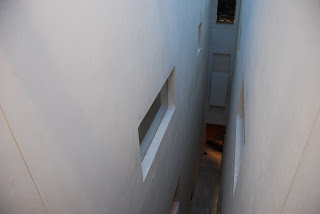I love post-modern museums. I took myself to the the National Museum of Scotland this afternoon; it is beautiful. I'm also totally in love with the new Royal Ontario Museum... the people who know me in real life, particularly in real life in Toronto, will likely have heard one of my regular defenses of the giant (much maligned) crystal on Bloor Street.
I love the way the spaces of many newly designed museums reflect an awareness of the process of collection and curation, using windows (often "oddly" placed) and other gaps in the architecture in a way that brings awareness to the outside world from inside the gallery, and can sometimes draw your attention to other galleries inside the museum, leading connections to be drawn between different times and places in the world through architectural slight of hand. I like how the architecture of modern, purpose-built museums can serve to break down the linearity of the story that the museum is trying to tell, as well as making it much more self-consciously subjective. I remember the old ROM being set out in a very linear manner, it told a story of progress and growth. It really is no longer like this, it invites you to get lost, and be surprised. Today I heard an employee in the museum of scotland say to a visitor "the whole thing's designed so you can turn the corner and be surprised... that means it's quite easy to get lost. Don't worry, I'll show you the way." Museums like this now tell a story that is self-referential and self-critical, questioning the educational role of the institution and our perception of history.
It was interesting to go to the Archives at Granton a few weeks ago, I've always had a sense that museums were like the part of the iceberg that shows above the water and the archives are the art below, and the Granton archives really confirmed that feeling. This was the first time I've been back in the Museum after seeing the archives, and the sense of the depth of the collection, but also the heavy editing that has gone on the choose what is shown was much more palpable.
Also, I found this thing, which I love:
It's a semi-cylindrical printing plate of a page from "the Scotsman" from tuesday June 19th 1872. Cast in type-metal from a pasteboard flong (flong is an awesome word.)
